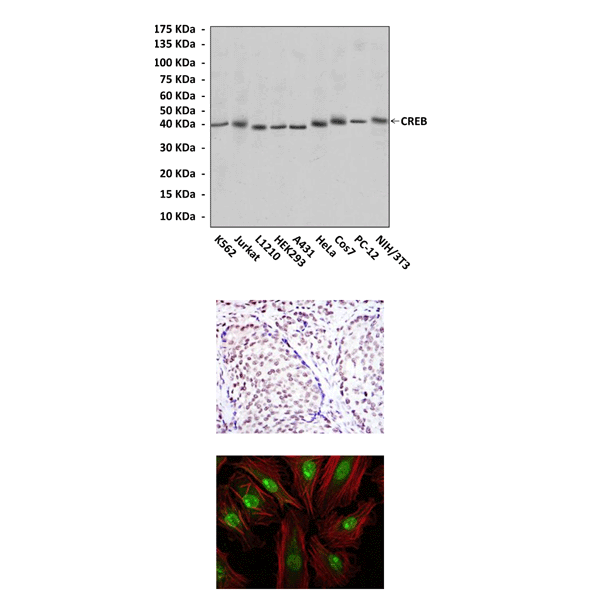Anti-CREB: Mouse CREB Antibody |
 |
BACKGROUND CREB is a member of the leucine zipper family of DNA binding proteins. This protein binds as a homodimer to the cAMP-responsive element (CRE), an octameric palindrome. CREB activates transcription of target genes in response to a diverse array of stimuli, including peptide hormones, growth factors, and neuronal activity, that activate a variety of protein kinases including protein kinase A (PKA), pp90 ribosomal S6 kinase (pp90RSK), and Ca2+/calmodulin-dependent protein kinases (CaMKs). These kinases all phosphorylate CREB at a particular residue, serine 133 (Ser133), and phosphorylation of Ser133 is required for CREB-mediated transcription.1 The transactivation domain of CREB consists of two major domains. The glutamine-rich Q2 domain, which interacts with the general transcription factor TAFII130/135, is sufficient for the recruitment of a functional RNA polymerase II complex and allows basal transcriptional activity. The kinase-inducible domain, however, mediates signal-induced activation of CREB-mediated transcription. It is generally believed that recruitment of the coactivators CREB-binding protein (CBP) and p300 after signal-induced phosphorylation of this domain at serine-133 strongly enhances CREB-dependent transcription. Transcriptional activity of CREB can also be potentiated by phosphoserine-133-independent mechanisms, and not all stimuli that provoke phosphorylation of serine-133 stimulate CREB-dependent transcription.2 Thus, the mechanism by which CREB activates transcription varies depending on the stimulus. In some cases, signaling pathways target additional sites on CREB or proteins associated with CREB, permitting CREB to regulate distinct programs of gene expression under different conditions of stimulation. Transcription activation is enhanced by the TORC coactivators which act independently of Ser-133 phosphorylation.3 In addition; CREB is implicated in synchronization of circadian rhythmicity.4
REFERENCES
1. Montminy, M.: Ann. Rev. Biochem. 66:807-22, 1997
2. Johannessen, M. et al: Cell. Signal. 16:1211-27, 2004
3. Conkright, M. D. et al: Mol. Cell12:413-23, 2003
4. Obrietan, K. et al: Nature Neurosci. 1:693-700,1998
2. Johannessen, M. et al: Cell. Signal. 16:1211-27, 2004
3. Conkright, M. D. et al: Mol. Cell12:413-23, 2003
4. Obrietan, K. et al: Nature Neurosci. 1:693-700,1998
Products are for research use only. They are not intended for human, animal, or diagnostic applications.
Параметры
Cat.No.: | CP10372 |
Antigen: | Raised against purified recombinant fragments of human CREB expressed in E. Coli. |
Isotype: | Mouse IgG1 |
Species & predicted species cross- reactivity ( ): | Human, Mouse, Rat |
Applications & Suggested starting dilutions:* | WB 1:1000 IP n/d IHC 1:50 - 1:200 ICC 1:50 - 1:200 FACS n/d |
Predicted Molecular Weight of protein: | 40 kDa |
Specificity/Sensitivity: | Detects CREB proteins without cross-reactivity with other family members. |
Storage: | Store at -20°C, 4°C for frequent use. Avoid repeated freeze-thaw cycles. |
*Optimal working dilutions must be determined by end user.
Документы
Информация представлена исключительно в ознакомительных целях и ни при каких условиях не является публичной офертой








